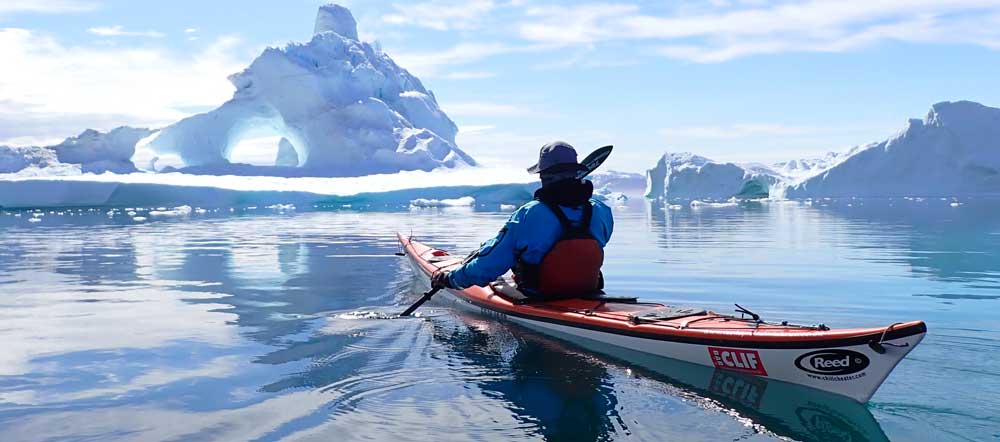Much attention has been given to equipment and kayak design. In my opinion, little thought has been given to the suitability of customising the paddle to suit paddling style, injury prevention, and optimising efficiency over a prolonged distance, taking into consideration different weather conditions and variable loads being carried. The following is not aimed at competing athletes but recreational kayakers who need an efficient technique and a suitable paddle.
It is also concluded that the paddle sport industry is not providing an adequate paddle range for the smaller kayaker. This research was initiated by the need to identify suitable paddles for smaller people who undertake expedition sea kayaking.
Our paddle size guide is based on information gathered over a fourteen-month period.
NOTE: None of the research related to Inuit-style blades.
The table was collated by observing paddle technique, linking it to an increase in performance together with an energy-efficient stroke.
All participants were initially videoed paddling forwards using their own paddle. Details of their paddle were recorded in order to make a comparison once the specification of the customised paddle had been finalised. The participants were then videoed paddling with the new recommended paddle.
One of the more surprising findings was that forward paddling technique improved considerably without any coaching once an appropriate paddle was used. I would now recommend that an in-depth coaching session should not take place until a suitable paddle has been identified. Once technique and strength have been improved, sometimes the paddler can increase the blade area without compromising technique.
When deciding on paddle length and blade area, you have two options:
1. A longer paddle with a smaller blade area.
2. A shorter paddle with a larger blade area.
If after using the table to determine paddle length, you feel that the blade area is still too large, then an alternative to a smaller blade is to reduce the shaft length.
If a paddle designed for efficient use in calm conditions was shortened by 2/3 cm, it would make a considerable difference in the amount of energy required to maintain an efficient forward paddling technique. You would effectively be changing down a gear. The table shows a suggested length of shaft to blade size. If you prefer a larger blade area, then shorten the shaft.
The average advanced paddler has a strike rate of approx 60 per minute when the paddle lengths correspond to the enclosed table (a strike is every time a blade hits the water).
People with differing frame sizes require different shaft thicknesses. As a way of standardising, I have taken the standard diameter of the shaft as being suitable for a medium-sized frame. I would recommend a shaft measuring 27mm in diameter for small-framed people. (See table) Large-framed people sometimes get tendonitis in their control hand. This is often due to the shaft being too small a diameter. This can easily be rectified by padding out the shaft.
Most small-framed paddlers would do well to use a smaller blade area than they would normally use when working on developing an efficient forward paddle technique. Move up a size when the technique is good.
INJURIES
Inappropriate paddles were found to cause the following injuries:
- Rotational cuff tendonitis
- Tendonitis of the hand
- Tendonitis of the forearm/wrist
- Shoulder Bursitis (calcific Tendonitis) Incorrectly sized paddles are also a contributing factor to causing partial or dislocated shoulders. Large blade areas combined with poor technique are the main cause.
The paddle is a lever that is used by the kayaker to drive the kayak forwards. The longer the lever, the greater a force will be placed on joints, muscles, and tendons. This, together with incorrectly sized paddle blades (area), will increase the chances of developing any of the above conditions.
Rotational cuff tendonitis: can be caused by using a paddle that is either too long or with blades that are too large in area for the kayaker. For people who suffer from this condition, I recommend reducing both the blade area and paddle length. The blade area needs to be considerably smaller than the kayaker would normally paddle with. Only after a period of time, provided the tendonitis improves, should you increase the blade size. Rotational cuff tendonitis is caused by damage to three small muscles and their tendons. These three tightly hold the ball and socket joint of the shoulder joint together. These run from the top of the shoulder blade to the top of the arm bone.
Tendonitis of the hand: This is sometimes helped by using a larger or smaller diameter shaft.
Tendonitis of the wrist or forearm: customising your paddle can help this condition (as described for rotational cuff tendonitis) or try a modified cranked shaft with a 65-degree feather or less. It is then possible to paddle without flexing your wrist, but you may have to adapt your forward paddling technique, paddling with straighter arms.
The hand is controlled by muscles, tendons, and nerves. Forearm muscles are connected to the hand by tendons that run across the wrist and into the hand. The tendons that control your thumb, unlike others, run through sheaths. The tendons are enclosed in these sheaths, and when they become irritated, extra synovial fluid is produced, which lubricates and feeds the tendons. The sheath cannot expand to accept this extra fluid; this results in the fluid pushing hard on the tendon, which in turn becomes inflamed. Over time, this causes the sheath to thicken, resulting in even less room for the tendon. The condition now becomes chronic, causing further swelling and pain. Immobilisation and rest are needed. Again, oversized paddles, overuse, and in some cases, compressed sheaths caused by tight latex rubber cuffs will cause this condition.
Shoulder Bursitis: this is primarily caused by overuse of the shoulder, but also by oversized paddles. The bursa sac lies between the underside of the shoulder blade and the rotator cuff tendons. The sac comprises specialised cells that produce joint fluid, called synovial fluid. The fluid also lubricates the sac and tendons. When aggravated, it promotes fluid production. This, in turn, makes the condition worse, causing swelling that becomes painful to the touch.
The correct choice of paddle, together with good technique, will go a long way to minimise the above conditions.
RECOMMENDATIONS
The sea kayaker adopts either of the following options:
- Purchase a set of two paddles. Both the same length but one having smaller blades. The paddler can then change down a gear by dropping to a smaller blade when weather conditions deteriorate.
- Purchase a one-piece paddle with interchangeable blades.
POSSIBLE OPTIONS
A paddle blade that is adjustable, i.e., telescopic.
For coaches, a split paddle with the option of assembling it with the following options: left-handed, right-handed, and unfeathered.
OTHER CONSIDERATIONS
A shorter paddle will generally mean an increase in stroke rate. A longer paddle will enable the kayaker to have a slower paddle rate. Both will result in the same kayak speed, but the shorter paddle will promote acceleration. The padlock system provides kayakers and coaches with the opportunity of experimenting and using split paddles as the main paddle with no wear on the joint.
OTHER RECOMMENDATIONS
Although a customised paddle will make a huge difference, we should also pay attention to customising the seat, in particular the angle of the seat and backrest. The seat may have to be raised at the rear in order to help assist the paddler lean forwards.





Kayak order form | Paddle enquiry form
Contact us | +44 (0) 1407 765550